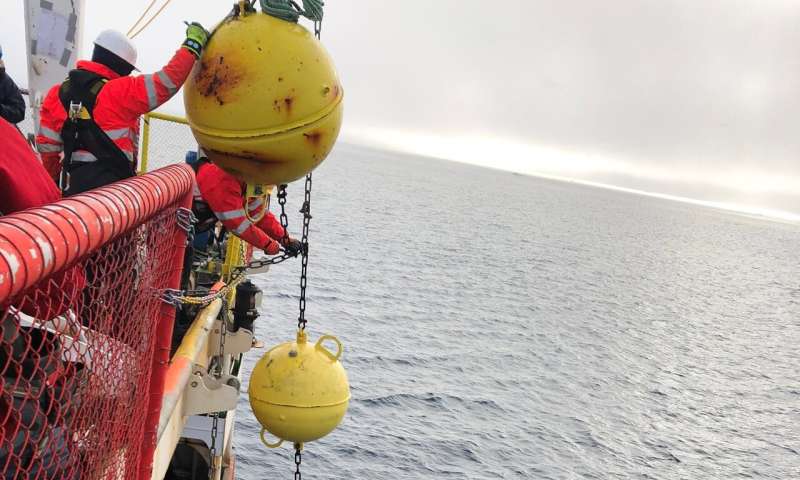It is rare these days to find confirmation of what we know is happening. Mostly it is misinformation and happy stories.
Arctic ocean moorings shed light on winter sea ice loss
by Heather McFarland, University of Alaska Fairbanks
20 August, 2020
The eastern Arctic Ocean's winter ice grew less than half as much as normal during the past decade, due to the growing influence of heat from the ocean's interior, researchers have found.
The finding came from an international study led by the University of Alaska Fairbanks and Finnish Meteorological Institute. The study, published in the Journal of Climate, used data collected by ocean moorings in the Eurasian Basin of the Arctic Ocean from 2003-2018.
The moorings measured the heat released from the ocean interior to the upper ocean and sea ice during winter. In 2016-2018, the estimated heat flux was about 10 watts per square meter, which is enough to prevent 80-90 centimeters (almost 3 feet) of sea ice from forming each year. Previous heat flux measurements were about half of that much.
"In the past, when weighing the contribution of atmosphere and ocean to melting sea ice in the Eurasian Basin, the atmosphere led," said Igor Polyakov, an oceanographer at UAF's International Arctic Research Center and FMI. "Now for the first time, ocean leads. That's a big change."
Typically, across much of the Arctic a thick layer of cold fresher water, known as a halocline, isolates the heat associated with the intruding Atlantic water from the sea surface and from sea ice.
This new study shows that an abnormal influx of salty warm water from the Atlantic Ocean is weakening and thinning the halocline, allowing more mixing. According to the new study, warm water of Atlantic origin is now moving much closer to the surface.
"The normal position of the upper boundary of this water in this region was about 150 meters. Now this water is at 80 meters," explained Polyakov.
A natural winter process increases this mixing. As sea water freezes, the salt is expelled from ice into the water. This brine-enriched water is heavier and sinks. In the absence of a strong halocline, the cold salty water mixes much more efficiently with the shallower, warm Atlantic water. This heat is then transferred upward to the bottom of sea ice, limiting the amount of ice that can form during winter.

"These new results show the growing and spreading influence of heat associated with Atlantic water entering the Arctic Ocean," added Tom Rippeth, a collaborator from Bangor University. "They also suggest a new feedback mechanism is contributing to accelerating sea ice loss."
Polyakov and his team hypothesize that the ocean's ability to control winter ice growth creates feedback that speeds overall sea ice loss in the Arctic. In this feedback, both declining sea ice and the weakening halocline barrier cause the ocean's interior to release heat to the surface, resulting in further sea ice loss. The mechanism augments the well-known ice-albedo feedback—which occurs when the atmosphere melts sea ice, causing open water, which in turn absorbs more heat, melting more sea ice.
When these two feedback mechanisms combine, they accelerate sea ice decline. The ocean heat feedback limits sea ice growth in winter, while the ice-albedo feedback more easily melts the thinner ice in summer.
"As they start working together, the coupling between the atmosphere, ice and ocean becomes very strong, much stronger than it was before," said Polyakov. "Together they can maintain a very fast rate of ice melt in the Arctic."
Polyakov and Rippeth collaborated on a second, associated study showing how this new coupling between the ocean, ice and atmosphere is responsible for stronger currents in the eastern Arctic Ocean.
According to that research, between 2004-2018 the currents in the upper 164 feet of the ocean doubled in strength. Loss of sea ice, making surface waters more susceptible to the effects of wind, appears to be one of the factors contributing to the increase.
The stronger currents create more turbulence, which increases the amount of mixing, known as shear, that occurs between surface waters and the deeper ocean. As described earlier, ocean mixing contributes to a feedback mechanism that further accelerates sea ice decline.
Accelerated currents have practical implications in the Arctic. Ship captains need accurate maps of currents for navigation. Since currents move sea ice, oil and gas extraction activities also need information about currents.
This second study was described in a scientific paper published in the Geophysical Research Letters.




No comments:
Post a Comment
Note: only a member of this blog may post a comment.